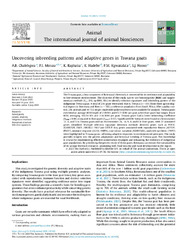| dc.contributor.author | Chalebgwa, Amantle Bonolo | |
| dc.contributor.author | Monau, Phetogo Ineeleng | |
| dc.contributor.author | Raphaka, Kethusegile | |
| dc.contributor.author | Mdladla-Hadebe, Khanyisile | |
| dc.contributor.author | Kgwatalala, Patrick Monametsi | |
| dc.contributor.author | Nsoso, Shalaulani James | |
| dc.date.accessioned | 2025-10-22T08:09:09Z | |
| dc.date.available | 2025-10-22T08:09:09Z | |
| dc.date.issued | 2025-08 | |
| dc.identifier.citation | Chalebgwa, A. B., Monau, P. I., Raphaka, K., Hadebe, K., Kgwatala, P. M., & Nsoso, S. J. (2025). Uncovering inbreeding patterns and adaptive genes in Tswana goats. animal, 101592. | en_US |
| dc.identifier.issn | 1751-732X | |
| dc.identifier.uri | https://www.sciencedirect.com/science/article/pii/S1751731125001752 | |
| dc.identifier.uri | https://hdl.handle.net/13049/802 | |
| dc.description | Journal Article | en_US |
| dc.description.abstract | The Tswana goat, a key component of Botswana’s livestock, is renowned for its resilience and adaptability to low-resource environments. The objective of this study was to use homozygosity (ROH) and supplementary methods (FST, iHS, xp-EHH, Rsb) to identify selection signatures and inbreeding pattern of the indigenous Tswana goat. A total of 216 goats were used, that is, Tswana (n = 114) from three agroecological regions in Botswana and Boer (n = 102), a reference population from South Africa. After quality control, 216 animals and 49 732 single−nucleotide polymorphisms were available for analysis. Tswana goats exhibited an average ROH length of 2.20 Mb and 85.71 ROH per goat, while Boer goats had longer, fewer ROH, averaging 155.96 Mb and 3.14 ROH per goat. Tswana goats had a lower inbreeding coefficient (FROH = 0.08) compared to Boer goats (FROH = 0.13). Significant ROH hotspots were found on chromosomes 12, 6, and 5 in Tswana goats and on chromosomes 24, 14, 9, 8, and 6 in Boer goats, with 27 annotated genes identified. Multiple selection signature detection methods detected genes such as PUS7L, ADAMTS20, TWF1, PRICKLE1 YAF2 and GXYLTI. Key genes associated with reproductive fitness (ATP12A, RNF17), immune response (IL17D, PARP4), coat colour variation (ADAMTS20), and milk synthesis (TWF1) were highlighted in Tswana goats, reflecting adaptive responses to environmental pressures. The study provides insights into the genetic adaptations and historical breeding of Tswana goat. This knowledge is crucial for implementing effective conservation strategies and enhancing the resilience of indigenous goat populations. By prioritising the genetic study of these goats, Botswana can ensure the sustainability of its unique livestock resources, promoting both food security and rural development in the region. | en_US |
| dc.language.iso | en | en_US |
| dc.publisher | Elservier | en_US |
| dc.relation.ispartofseries | animal;Volume 19, Issue 8, August 2025, 101592 | |
| dc.subject | Autozygosity | en_US |
| dc.subject | Genetic diversity | en_US |
| dc.subject | Indigenous livestock | en_US |
| dc.subject | Population structure | en_US |
| dc.subject | Selection signatures | en_US |
| dc.title | Uncovering inbreeding patterns and adaptive genes in Tswana goats | en_US |
| dc.type | Article | en_US |

